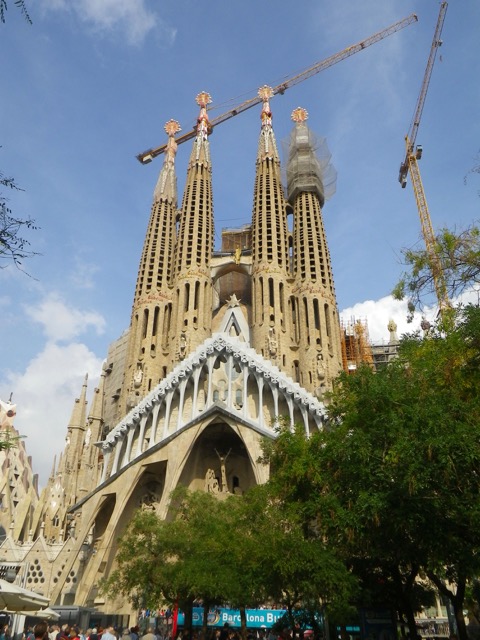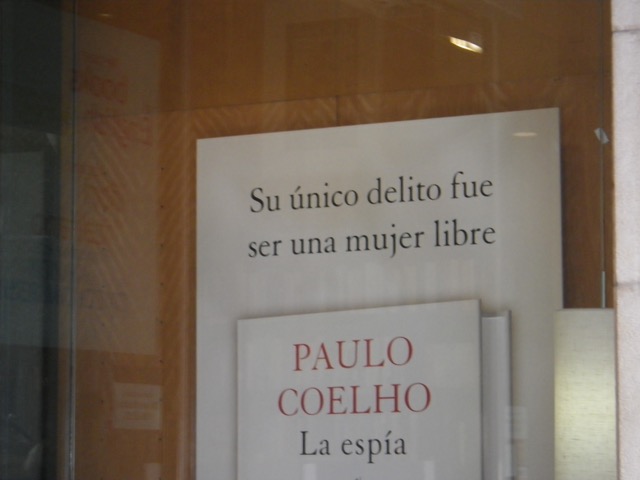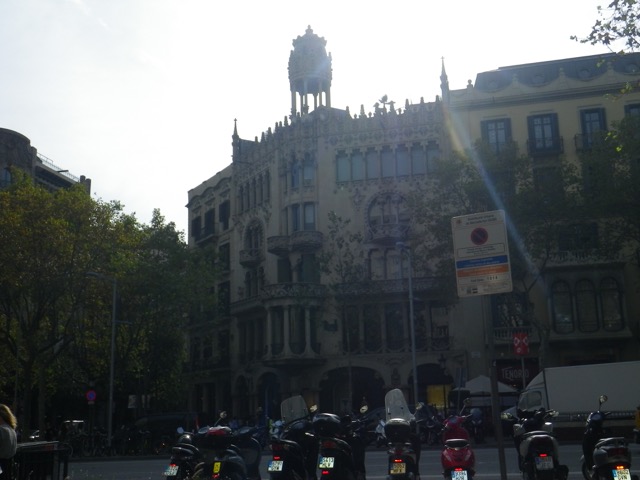I don’t know if it’s residual jet lag despite my having been in Europe four months, but I tend to wake up about five hours after going to sleep, read a bit, and then manage to sleep for another two to three hours. I went to sleep around 2AM this morning and when I groggily woke up some time later, I thought there was no way it would be 7:00. It was 7:30! I couldn’t believe how dark my room was. I heard my host get up at some point, but managed to get back to sleep until about 10:00, when things got really loud in the building. Not a great night, but not terrible either.
Since I had no food with me and hadn’t eaten since my sandwich last night, that was my first priority. I pulled up directions on my phone to the nearest tourist info centre so I could get a paper map and headed out.
I’ve chosen to approach Barcelona rather like I did London. I never thought I’d get here and there isn’t anything I feel I must do. Moreover, I am not on a vacation budget and having spoiled myself rotten in the last four months in the affordable Balkans, it doesn’t feel like a punishment to do Barcelona on a shoestring. So I’m happy with spending my free time ambling around and seeing what I come across. I will take a free walking tour tomorrow, though.
This church is on my street.
I’d done my research on mealtimes in Barcelona and knew that I wouldn’t do better than a coffee and pastry for breakfast at 11AM. So I popped into the first café I found (at the end of my street). Prices were terrifying, but it is what it is. A normal coffee was a small mugful and had milk in it, a pleasant surprise on both counts.
I made my way to Plaça de Catalunya, an important square in downtown Barcelona on the edge of the old city. I knew I would find there not just the tourist info centre, but also a SIM card for my phone. I’ve been doing without phone service since I arrived in Sarajevo, not having been in any one country long enough to make it worth getting one, and I’ve really missed it. Since I will be in Spain at least two months, it was worth getting one here.
Here is a fountain in Catalonia Square:
And one of the many buildings around it.
There was a huge lineup at the tourist info centre, which is underground, so I just grabbed a free map and went back above ground to Movistar’s Mobile World Centre store in the hope of getting a SIM card. The set up was similar to a Telcel store in Mexico, where you go to an info desk to say what you want and are assigned a number and a queue based on your enquiry. This first attendant asked me if I had my passport as, like in Bulgaria, your SIM has to be registered. It was then a longish wait to be told they were out of rechargeable mobile SIMs. Since the attendant got snappy with me when I asked her at one point to please slow down, I was glad to have an excuse not to give Movistar my business. But the attendant did redeem herself a bit when she said that the El Cortes Inglés department store next door has a telecom section on the seventh floor, but she had no info beyond that.
I went into the fancy schmancy store and up seven very slow escalators to find a whole floor devoted to telecom with counters by different companies. I’d done some preliminary research and knew that everyone has comparable prices and coverage. So when an attendant from Vodafone asked if she could help me, that was that. For 21 euro, I got a rechargeable SIM with 2GB good for one month, 100 minutes anywhere in Spain, and I think unlimited text messaging. I asked if I could get an Almería number and she said that the numbers are good for all of Spain. She registered the SIM using my passport info and then did her thing to put the SIM in and get it set up. The process was much quicker than it is in Mexico and comparable to what I experienced in the Balkans.
Phone sorted, I headed to the Gothic Quarter, the old part of Barcelona.
I wasn’t really “feeling” how touristy and full of expensive shops the area was so I started to duck into narrow alleys to get a tiny bit off the tourist track.
But it was hard to get lost.
I LOVE Gothic architecture. I’ve seen some gorgeous churches in the Balkans, but there’s just something about Gothic design that makes my heart skip a beat.
I’m not sure how I managed to fill three whole hours from leaving home, but I did! 2PM is the start of lunch hour here and I knew to look for a “menú del día,” a three-course menu for a set price, usually around 10 euro. I’d seen a few menus by the time I was ready to eat and had gotten an idea of what to expect. So I just went into the first restaurant I saw that had a menu with things that sounded good and that would be good value, that had no English on the menu, and that didn’t have tourists!
For my first course, I went with Greek salad. I wasn’t expecting just tomatoes and cheese, but it was very good and the included bread was perfect for mopping up the dressing. Yes, that’s a beer behind my plate, included in my 10 Euro cost! I got the beer because it was more monetary value than a soft drink and, well, you know me and beer.
My second course wasn’t worth a photo, just soggy frozen fries with a very generous portion of moist grilled chicken breasts without any sauce or seasonings. Like in the Balkans, there was oil and vinegar on the table, so I used the vinegar (balsamic) to spice up my meal a bit and make the fries nicer. The chicken really hit the spot!
There were a lot of options for dessert, including cake and fresh fruit. The waiter and I shared a laugh when, after he listed all the dessert options, I said, “The first one, please,” and he had to remember what it was!
It was a vanilla cake with nuts and really good!
And the menu. Which, thankfully, was in Spanish, not Catalan! The first thing on the menu is peas sautéd with ham. I was surprised by how many people were eating that as they were not even nice fresh sweet peas. The first item for the second course is rabbit and I have to say I was tempted to try it.
One thing I will like about eating out in Barcelona that I also liked in London is that you don’t have to tip!
I then decided to amble over to Barcelona’s most famed landmark, the Sagrada Familia Basilica.
“A coffee a day is the key to happiness.”
These little motorcycles seem to be a very popular mode of transportation in Barcelona.
Now, this is how you do an Arch of Triumph!
This part of Barcelona is a feast for the eyes!
I was rather underwhelmed by the Sagrada Familia Basilica…
Until I got closer!
I was tired and had about a 5KM walk back home so the plan was to route myself home from here with my phone. But my phone went from 20% battery capacity to dead as I was doing that!!! My street was not on the map! I decided that I would use my map to route myself back to Catalonia Square and from there try to retrace my steps from the morning. Once I got closer to Poble Sec, I could ask for directions if I got stuck.
This is the scooter I’d buy.
I like seeing the name of my country when out of it.
Catalan really does look like a hybrid of French and Spanish. “Sweet Catalonia, homeland of my heart…” and off to Google translate I go. 
I love the random owl on the building!
“Her only crime was to be a free woman.” Need to check out this book!
Such quirky buildings!
So many scooters! This is back at Catalonia Place.
From there, I knew I had to take the famous La Rambla pedestrian street. I racked my brain trying to remember the name of the street I’d taken to turn off onto La Rambla and suddenly remembered that it was similar to the name of one of Contessa‘s dogs, Carme (the dog is Carmeh!). From there, I very slowly retraced my steps, looking for familiar landmarks and names I could remember.
I did really well until I got to one large boulevard that did not look familiar at all. I was in an area that was still on the map, but which did not have the names of the little streets. I was able to locate that boulevard and then another big one that I recognised, which was in the opposite direction than I’d turned down the first boulevard. I turned around, made my way to the second boulevard, and from there, I recognised the café where I’d had breakfast. Behold, the church on my street!
It was a lovely low-key first day in Barcelona. I’ll admit that I’m having a bit of sticker shock, which is tamping down my enthusiasm a bit. I wish I could have made the 11AM walking tour of the Gothic Quarter today, but it will happen tomorrow and I will have more juicy details to share rather than just general impressions. But I am very happy to be here, thrilled that I can understand people and they me, the weather is gorgeous, there’s palm trees, and the city is so much more walkable than many Balkan cities I’ve been to (sidewalks!!!).
I’m going to attempt to call it an early night so that I can get the bulk of tomorrow’s work done before my tour… I have two nice workspaces here, the kitchen table and the terrace, so I should be comfortable.
































































